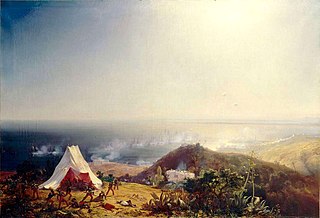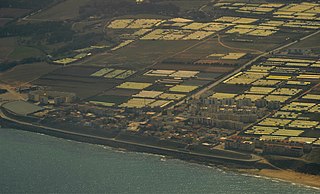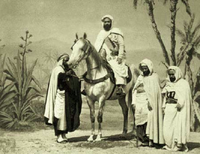A request that this article title be changed to Invasion of Algiers (1830) is under discussion. Please do not move this article until the discussion is closed. |
| Invasion of Algiers | |||||||
|---|---|---|---|---|---|---|---|
| Part of the French conquest of Algeria | |||||||
 Attaque d'Alger par la mer 29 Juin 1830, Théodore Gudin | |||||||
| |||||||
| Belligerents | |||||||
| Commanders and leaders | |||||||
| Units involved | |||||||
| Makhzen tribal levy [2] | |||||||
| Strength | |||||||
Expeditionary army:
3,988 horses Naval forces: 103 warships 464 transport ships 27,000 sailors [7] | 25,000-50,000 [8] [9] [10] [11] [12] | ||||||
| Casualties and losses | |||||||
| 415 killed 2,160 wounded [13] [14] [15] | over 5,000 [16] | ||||||
The invasion of Algiers in 1830 was a large-scale military operation by which the Kingdom of France, ruled by Charles X, invaded and conquered the Deylik of Algiers.
Algiers was annexed by the Ottoman Empire in 1529 after the capture of Algiers in 1529 and had been under direct rule until 1710, when Baba Ali Chaouch achieved de facto independence from the Ottomans, though the Regency was still nominally a part of the Ottoman Empire. [17]
The Deylik of Algiers elected its rulers through a parliament called the Divan of Algiers. These rulers/kings were known as Deys. The state could be best described as an Elective monarchy. [18]
A diplomatic incident in 1827, the so-called Fan Affair (Fly Whisk Incident), served as a pretext to initiate a blockade against the port of Algiers. After three years of standstill and a more severe incident in which a French ship carrying an ambassador to the dey with a proposal for negotiations was fired upon, the French determined that more forceful action was required. Charles X was also in need of diverting attention from turbulent French domestic affairs that culminated with his deposition during the later stages of the invasion in the July Revolution.
The invasion of Algiers began on 5 July 1830 with a naval bombardment by a fleet under Admiral Duperré and a landing by troops under Louis Auguste Victor de Ghaisne, comte de Bourmont. The French quickly defeated the troops of Hussein Dey, the Deylikal ruler, but native resistance was widespread. This resulted in a protracted military campaign, lasting more than 45 years, to root out popular opposition to the colonisation. The so-called "pacification" was marked by resistance of figures such as Ahmed Bey, Abd El-Kader and Lalla Fatma N'Soumer.
The invasion marked the end of the several centuries old Regency of Algiers, and the beginning of French Algeria. In 1848, the territories conquered around Algiers were organised into three départements, defining the territories of modern Algeria.

















